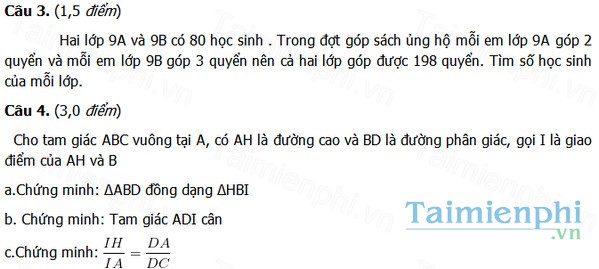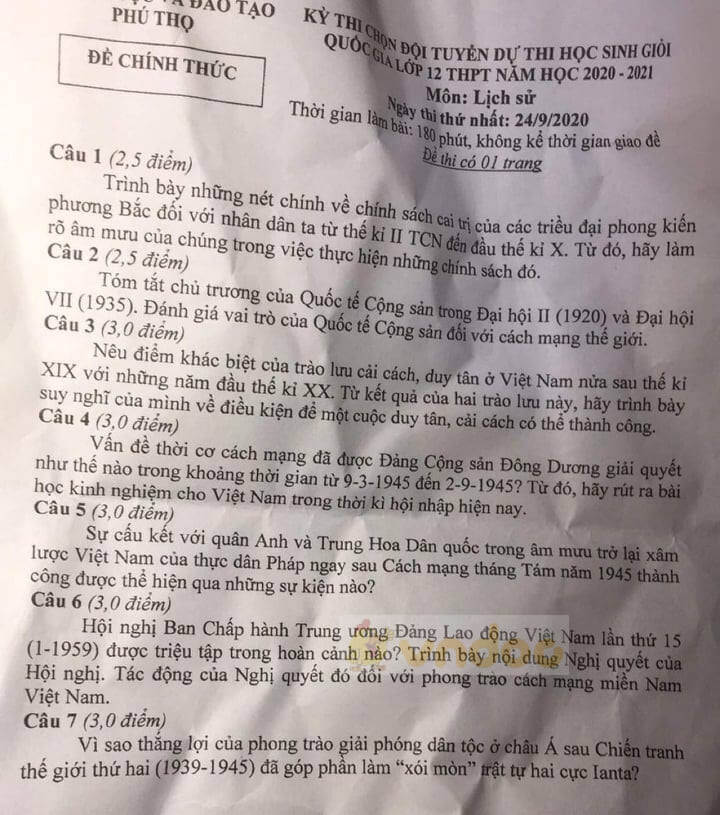Ai thi học kì rồi thì cho mik đề nha!Toan,van,anh,sinh,su,li!!(lop 7)
Hãy nhập câu hỏi của bạn vào đây, nếu là tài khoản VIP, bạn sẽ được ưu tiên trả lời.



Câu 3:
Gọi số học sinh lớp 9A là \(x\)(học sinh) (điều kiện: \(x\inℕ^∗;x< 80\)).
Số học sinh lớp 9B là \(80-x\)(học sinh).
Tổng số quyển sách lớp 9A góp được trong đợt góp sách ủng hộ là \(2x\)(quyển sách).
Tổng số quyển sách lớp 9B góp được trong đợt góp sách ủng hộ là \(3\left(80-x\right)\)(quyển sách).
Vì lớp 9A và 9B góp được 198 quyển nên ta có phương trình:
\(2x+3\left(80-x\right)=198\).
\(\Leftrightarrow2x+240-3x=198\).
\(\Leftrightarrow2x-3x=198-240\).
\(\Leftrightarrow-x=-42\).
\(\Leftrightarrow x=42\)(thỏa mãn điều kiện).
Số học sinh lớp 9B là \(80-42=38\).
Vậy lớp 9A có 42 học sinh, lớp 9B có 38 học sinh.


I. Choose the word which has the underlined part pronounced differently from the others. (1mark)
1. A. Breakfast B. Teacher C. East D. Please
2. A. Children B. Church C. Headache D. Beach
3. A. See B. Salt C. Small D. Sugar
4. A. Mother B. Thirteen C. Father D. Then
II. Circle the word or phase (A, B, C or D) that best completes each of the following sentences. (2 marks)
1. Phuong doesn’t football and …… Mai.
A. so is B. so does C. does so D. neither does
2. These papayas aren’t ripe and ….. are the pineapples.
A. so B. too C. neither D. either
3.The dirt from vegetables can make you ……...
A. bored B. tired C. sick D. well
4. You must do your homework more ……. in the future.
A. careful B. care C. careless D. carefully
5. You should ……. early if you want to do morning exercise.
A. get up B. getting up C. to get up D. to getting up
6. Hoa is a ….. worker.
A. hardly B. hard C. more hard D. most hard
7. Last night we didn’t watch the film on TV because it was ……..
A. bore B. bored C. boring D. boredom
8 . Mai enjoys ….. sea food with her parents .
A. to eat B. eating C. eat D. to eating
III. Supply the correct forms of the verbs in brackets. (2 marks)
1. He (wash)………………………….the dishes everyday.
2. We (play)…………………………volleyball tomorrow
3. She (not watch) …………………TV last night.
4. ……… they (go) …………………….to school now?
IV. Write the sentences. Use the cue words. (3 marks)
1. I/not /read books
…………………………………………………………………………………….
2. He/be/good/soccer/player.He/play/soccer/good.
…………………………………………………………………………………….
3. Mai/prefer/meat/fish.
…………………………………………………………………………………….
4 They/prefer/listen/music/watch/TV
…………………………………………………………………………………….
5 He/do/homework/last night.
…………………………………………………………………………………….
5 Hoa/not go/school/yesterday/because/she/be/sick.
…………………………………………………………………………………….
V. Read the passage carefully then answer questions. (2 marks)
In 1960s, most people in Vietnam did not have a TV set. In the evening, the neighbors gathered around the TV. They watched until the TV programs finished. The children might play with their friends and the older people might talk together. Vietnam is different now. Many families have a TV set at home and the neighbors don’t spend much time together.
Questions:
1. Did most people have a TV set in 1960s?
………………………………………………………………………………
2.How long did they watch TV programs?
………………………………………………………………………………
3. What might the children do?
………………………………………………………………………………
4. What might the older people do?
………………………………………………………………………………
 Giúp mình bài này với cô giáo mình giao trên mạng cô bảo cô bảo cho hướng dẫn nhưng lại k cho
Giúp mình bài này với cô giáo mình giao trên mạng cô bảo cô bảo cho hướng dẫn nhưng lại k cho
mỗi nơi một khác với lại nhu vay là gian lận thi cử bn rõ chưa!
Đề thì có thể cho nhưng mỗi huyện, thành phố mình nghĩ sẽ ra đề khác nhau chứ bạn!